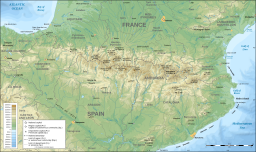Mallos de Riglos facts for kids
Quick facts for kids Mallos de Riglos |
|
|---|---|
| Highest point | |
| Elevation | 1,045 m (3,428 ft) |
| Geography | |
| Location | Hoya de Huesca, Aragon, Spain |
| Parent range | Pre-Pyrenees |
| Geology | |
| Mountain type | Conglomerate (Miocene) |
| Climbing | |
| First ascent | Unknown |
| Easiest route | From Las Peñas de Riglos |
The Mallos de Riglos are amazing rock formations in Spain. They look like giant stone fingers pointing to the sky! These huge rocks are found near a village called Las Peñas de Riglos. This area is in Aragon, which is a region in northern Spain. The Mallos are about 45 kilometers (28 miles) northwest of the city of Huesca.
These towering rocks are part of the Pre-Pyrenees mountains. They stand about 300 meters (980 feet) tall from their base. Their highest point is around 1000 meters (3300 feet) above sea level. The name "Mallos" means "mallets" in English, which describes their unique shape.
Contents
How the Mallos de Riglos Formed
The Mallos de Riglos are made of a special type of rock called conglomerate. Imagine a giant natural concrete! This rock formed over millions of years.
Rocks from the Pyrenees
Long ago, the Pyrenees mountains were much taller. Rain and wind slowly broke down the mountain slopes. Bits of rock, sand, and pebbles washed down into lower areas. These pieces were carried by ancient rivers.
Cemented by Limestone
Over time, these rock pieces piled up. Natural limestone acted like glue. It cemented all the different bits of rock together. This mixture became very hard. It formed a huge mass of conglomerate rock.
Shaped by Erosion
After millions of years, the softer parts of this conglomerate rock wore away. Wind and water slowly carved out the less resistant areas. The harder, stronger parts remained. These parts became the tall, impressive towers we see today. This process created the unique shapes of the Mallos de Riglos.
Climbing the Mallos
The Mallos de Riglos are very popular for rock climbing. Their sides are almost straight up and down. This makes them a challenging and exciting place for climbers. People come from all over the world to test their skills on these giant rock walls.
Gallery
See also
 In Spanish: Mallos de Riglos para niños
In Spanish: Mallos de Riglos para niños



